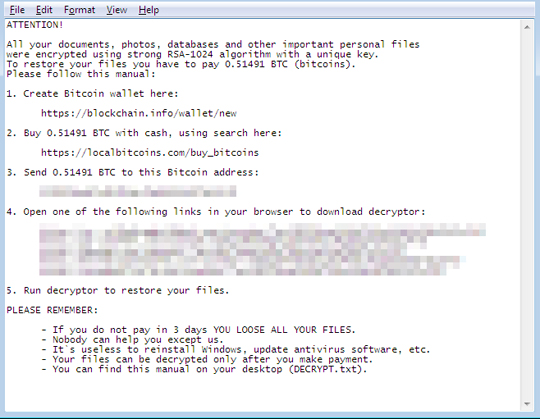RANSOM_ZIPPY.A
JS/TrojanDownloader.Nemucod.RS trojan (ESET), JS/Nemucod.hn (McAfee)
Windows


Threat Type: Trojan
Destructiveness: No
Encrypted: Yes
In the wild: Yes
OVERVIEW
Downloaded from the Internet, Spammed via email
This Trojan arrives as an attachment to email messages spammed by other malware/grayware or malicious users. It arrives on a system as a file dropped by other malware or as a file downloaded unknowingly by users when visiting malicious sites.
It connects to certain URLs. It may do this to remotely inform a malicious user of its installation. It may also do this to download possibly malicious files onto the computer, which puts the computer at a greater risk of infection by other threats. It executes the downloaded files. As a result, malicious routines of the downloaded files are exhibited on the affected system.
TECHNICAL DETAILS
Varies
JS
No
18 Apr 2016
Connects to URLs/IPs, Encrypts files
Arrival Details
This Trojan arrives as an attachment to email messages spammed by other malware/grayware or malicious users.
It arrives on a system as a file dropped by other malware or as a file downloaded unknowingly by users when visiting malicious sites.
Other System Modifications
This Trojan adds the following registry entries:
HKEY_CURRENT_USER\Software\Microsoft\
Windows\CurrentVersion\Run
Crypted = "%User Temp%\a.txt"
HKEY_CLASSES_ROOT\.crypted
(Default) = "Crypted"
HKEY_CURRENT_USER\Crypted\shell\
open\command
(Default) = "notepad.exe %User Temp%\a.txt"
Dropping Routine
This Trojan drops the following files:
- %Desktop%\DECRYPT.txt - ransom note
- %User Temp%\a.txt - ransom note
(Note: %Desktop% is the desktop folder, where it usually is C:\Documents and Settings\{user name}\Desktop in Windows 2000, Windows Server 2003, and Windows XP (32- and 64-bit); C:\Users\{user name}\Desktop in Windows Vista (32- and 64-bit), Windows 7 (32- and 64-bit), Windows 8 (32- and 64-bit), Windows 8.1 (32- and 64-bit), Windows Server 2008, and Windows Server 2012.. %User Temp% is the user's temporary folder, where it usually is C:\Documents and Settings\{user name}\Local Settings\Temp on Windows 2000, Windows Server 2003, and Windows XP (32- and 64-bit); C:\Users\{user name}\AppData\Local\Temp on Windows Vista (32- and 64-bit), Windows 7 (32- and 64-bit), Windows 8 (32- and 64-bit), Windows 8.1 (32- and 64-bit), Windows Server 2008, and Windows Server 2012.)
Download Routine
This Trojan connects to the following malicious URLs:
- http://{BLOCKED}l.com/counter/?ad={ad}&ky={ZIP password}&id={id}&rnd={random}
- http://{BLOCKED}allymla.com/counter/?ad={ad}&ky={ZIP password}&id={id}&rnd={random}
- http://{BLOCKED}feel.com/counter/?ad={ad}&ky={ZIP password}&id={id}&rnd={random}
- http://{BLOCKED}ng.com/counter/?ad={ad}&ky={ZIP password}&id={id}&rnd={random}
- http://{BLOCKED}tang.com/counter/?ad={ad}&ky={ZIP password}&id={id}&rnd={random}
It saves the files it downloads using the following names:
- %User Temp%\a0.exe - legitimate application to ZIP files
- %User Temp%\a{number}.exe
(Note: %User Temp% is the user's temporary folder, where it usually is C:\Documents and Settings\{user name}\Local Settings\Temp on Windows 2000, Windows Server 2003, and Windows XP (32- and 64-bit); C:\Users\{user name}\AppData\Local\Temp on Windows Vista (32- and 64-bit), Windows 7 (32- and 64-bit), Windows 8 (32- and 64-bit), Windows 8.1 (32- and 64-bit), Windows Server 2008, and Windows Server 2012.)
It then executes the downloaded files. As a result, malicious routines of the downloaded files are exhibited on the affected system.
Other Details
This Trojan encrypts files with the following extensions:
- *.zip
- *.rar
- *.7z
- *.tar
- *.gz
- *.xls
- *.xlsx
- *.doc
- *.docx
- *.rtf
- *.ppt
- *.pptx
- *.sxi
- *.odm
- *.odt
- *.mpp
- *.ssh
- *.pub
- *.gpg
- *.pgp
- *.kdb
- *.kdbx
- *.als
- *.aup
- *.cpr
- *.npr
- *.cpp
- *.bas
- *.asm
- *.cs
- *.php
- *.pas
- *.vb
- *.vcproj
- *.vbproj
- *.mdb
- *.accdb
- *.mdf
- *.odb
- *.wdb
- *.csv
- *.tsv
- *.psd
- *.eps
- *.cdr
- *.cpt
- *.indd
- *.dwg
- *.max
- *.skp
- *.scad
- *.cad
- *.3ds
- *.blend
- *.lwo
- *.lws
- *.mb
- *.slddrw
- *.sldasm
- *.sldprt
- *.u3d
- *.jpg
- *.tiff
- *.tif
- *.raw
- *.avi
- *.mpg
- *.mp4
- *.m4v
- *.mpeg
- *.mpe
- *.wmf
- *.wmv
- *.veg
- *.vdi
- *.vmdk
- *.vhd
- *.dsk
It does the following:
- It archives files using a password and appends the extension .crypted
NOTES:
It opens the dropped ransom note DECRYPT.TXT using notepad:

SOLUTION
9.800
12.474.06
18 Apr 2016
12.475.00
19 Apr 2016
Step 1
Before doing any scans, Windows XP, Windows Vista, and Windows 7 users must disable System Restore to allow full scanning of their computers.
Step 2
Note that not all files, folders, and registry keys and entries are installed on your computer during this malware's/spyware's/grayware's execution. This may be due to incomplete installation or other operating system conditions. If you do not find the same files/folders/registry information, please proceed to the next step.
Step 3
Restart in Safe Mode
Step 4
Delete this registry value
Important: Editing the Windows Registry incorrectly can lead to irreversible system malfunction. Please do this step only if you know how or you can ask assistance from your system administrator. Else, check this Microsoft article first before modifying your computer's registry.
- In HKEY_CURRENT_USER\Software\Microsoft\Windows\CurrentVersion\Run
- Crypted = "%User Temp%\a.txt"
- Crypted = "%User Temp%\a.txt"
- In HKEY_CLASSES_ROOT\.crypted
- (Default) = "Crypted"
- (Default) = "Crypted"
- In HKEY_CURRENT_USER\Crypted\shell\open\command
- (Default) = "notepad.exe %User Temp%\a.txt"
- (Default) = "notepad.exe %User Temp%\a.txt"
Step 5
Search and delete this file
- %Desktop%\DECRYPT.txt
- %User Temp%\a.txt
- %User Temp%\a{number}.exe
- %User Temp%\a0.exe
Step 6
Restart in normal mode and scan your computer with your Trend Micro product for files detected as RANSOM_ZIPPY.A. If the detected files have already been cleaned, deleted, or quarantined by your Trend Micro product, no further step is required. You may opt to simply delete the quarantined files. Please check this Knowledge Base page for more information.
Did this description help? Tell us how we did.


